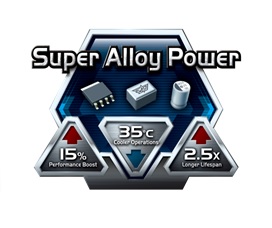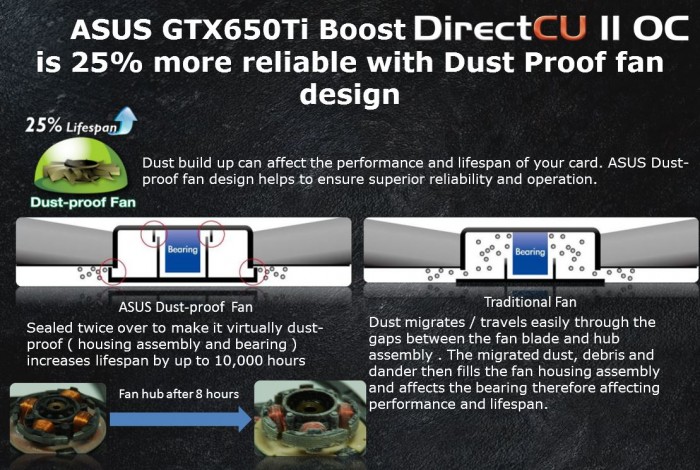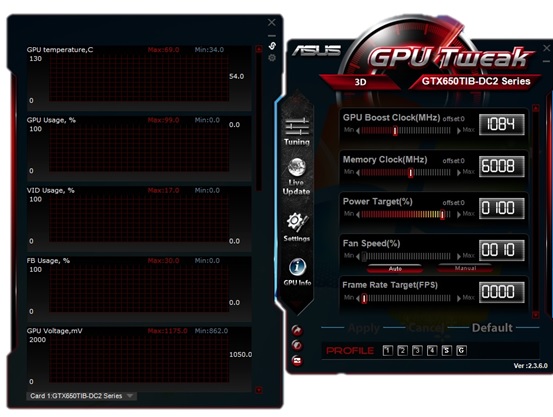ASUS has put outs its variation of the new GeForce GTX 650 Ti Boost with the DirectCU II cooler and SAP components. Let’s see what exactly this model has to offer to make it worth your cash.
Introduction – ASUS GeForce GTX 650 Ti Boost DirectCU II

ASUS as always has its own special way of doing things when it comes to GPUs and when we heard of the 650 Ti Boost model we knew it wouldn’t be long until we received one sporting the SAP components and DirectCU II cooling. From what we can tell ASUS did not put a TOP model card out for the 650 Ti Boost but then again it seems like they have tried to keep that shored up into the higher end models which leaves us with a standard model and a OC part.
The ASUS GeForce GTX 650 Ti Boost models are presently available at Newegg as only the OC sku at a street price of $174.99 This places it at the lower middle range of the other 650 Ti Boost offerings and about even with what you would expect in relation to the level of overclock. One thing that did surprise us is that ASUS normally launches with the highest clock from the factory on their model cards but vendors such as EVGA have definitely set their sights here as they offer their superclock card with a base clock almost as high as ASUS’ boost clock which leads me to believe that EVGA has sat back long enough and may want to start nipping the crown with the top out of the box clocks with such aggressive clock settings.
Key Features
SAP (Super Alloy Power)
ASUS has great pride in the components they infuse into their graphics offerings, very much like the motherboards we have covered previously. ASUS has what’s called a SAP or Super Alloy Power, which covers the components in the very VRM we are discussing. The components are hand picked for quality and performance based around not only power delivery but efficiency as well. The components in the SAP solution are super durable for a rated lifespan of up to 2.5x what reference cards would offer.
Here we see a short detailing of the SAP components and some short informational quips about how they help make for a better card. One thing here is that this is only the surface of what it is truly, as the SAP solution is a complete package of all of these components designed to work together giving not just higher power delivery than reference but also better voltage accuracy and efficiency through the digital voltage control and component selection and design.
Here we have some good detailing directly from ASUS, showing the improvement of the SAP choke component and how it is superior to other designs implemented presently. Other model chokes can make a whine or screeching sound due to the coil vibration, something we’re sure many enthusiasts and overclockers have heard before. The ASUS design has a sealed/filled core to inhibit vibration, which means noise free operation under extreme loading conditions. Another thing to remember is movement makes heat and friction, so less movement will mean cooler running components.
Here ASUS shows off its SAP selection for MOSFET components. These are designed to not only be more efficient but also have a higher power handling capability, which allows them to have extra head room for overclocking, should you really want to push the limit. Also note, the small package design of the SAP component as it is much smaller than the standard or generic MOSFET used on some standard or reference model cards. This allows for a larger VRM design to fit into a smaller space so that you can pack more punch without effecting the tight real estate within the chassis.
The SAP Solid state cap selection are Japanese units with a much higher MTBF than what you may see on other designs. These units are designed to have a very high expected lifetime, which allows users to rest assured that in their gaming rig with these components should have a nice happy life with a very low chance of failure for quite a long time (up to 2.5x as longer than competing components). For those of us that like to throttle our cards and really put the squeeze on them, this means we have the capability built in as the components are solid and reliable and ready to take a pounding.
DCII (Direct CU II)
ASUS DirectCU II coolers are the ASUS way of saying maximum cooling and plenty of quiet with one naming scheme. DirectCU II coolers are direct touch heatpipes to the GPU surface, ensuring the heat is wicked away from the GPU and up into the cooling fin array as quickly as possible. From there, the custom shrouded dual fans push air through the fins effectively but most important quietly to keep the GPU as cool as possible so hopefully it will never hit a temp to need a higher or noisier fan speed. The air pushing through the fin array also helps cool board components and the VRM as well, which is a nice little added bonus to this style cooler since we all know cooler components tend to run stronger, longer and with better efficiency.
As you see above the heatpipes on this cooler come directly to the GPU and pull the heat to the large aluminum fin area where it can be dissipated to the outside air. One thing worth noting is taht chassis airflow to some degree si needed to pull the air exhausted by this card out since it does exhaust most of its expelled heat into the chassis directly..
Dust proof Fan Technology
You would think that by now everyone would know that one of the number one killer of a fan is the dirt and dust it comes into contact with. Many fans simply are not sealed in such a way that it can keep dust out and in many cases they are not sealed at all, and you can see the sensitive winding area clearly exposed just by looking at the gap.
Here you can see that the ASUS solution is not just sealing the hub from dust but having 2 levels of sealing which means that over the lifespan of the cooler you can expect a much lower likelihood that you will get the grinding or simply the failing that you normally get from the unprotected fan as seen above.
We cannot count how many times we have had a perfectly good card or cooler just to have it become useless because the fan died.
GPU Tweak
ASUS offers its own software utility and its functionality has grown with generations just like the cards it supports. Of course the card can be overclocked but also voltages can be tweaked and within the GPU Tweak app, we can even launch the GPU info utility which is a full custom version of GPUz. This is a really cool feature and a benefit especially to benchmarkers, who we can definitely see using this card with some of the awesome tweaks we will discuss in the card overview.
There are many tools within the GPU Tweak menus some a little more hidden than others. First off directly form the GPU Tweak utility itself you can check for BIOS updates and even update from within the program. For anyone who’s ever updated a vBIOS before knows that having a tool that can do this in a mere few clicks is really handy.
The charts besides offering real time monitoring can also be setup to log thermals, voltages and clocks so that after benchmark or gaming runs you can see if there was any thermal issues or throttling that may have affected performance.
GPU Boost
Nvidia implemented the GPU Boost feature on the new Nvidia GeForce 6 series GPU’s of the Kepler Architecture. This allows the card to have a base clock and it adjusts dynamically or overclocks to a speed of up to a certain amount depending upon the thermal and power envelope. This makes Overclocking these cards a bit different as you now are overclocking with a boost clock and by offsets from the out of the box clocks. We will discuss more of the overclocking aspects in the overclocking section but it does need to be noted. The voltage envelope can be adjusted as well with another offset setting. This will raise the ceiling in most cases for more overclocking headroom pending temps are within check which with this cooler should not be much of an issue.
Adaptive V-Sync
Nvidia also included another feature as of recent called “Adaptive V-Sync” which allows for better performance while also stutter free gameplay by actively enabling and disabling V-Sync depending upon gaming situation and FPS all without any intervention from the user.
PCI-E Power LEDs
One really cool feature is that there are status LED’s on each PCI-E connector and these help you recognize that power is actively being sent to each connector of the card. (Note: picture is for reference purposes only as the care reviewed today employs only a single PCIe connector and single red and green LEDs)
The dual greens seen above indicate everything is working well. However if the PCI-E cable is not active or is not installed at all, it will give you the red light which tells you something is wrong. We could definitely see some value in this when diagnosing multi card setups or even single card issues. A dead PCI-E power cable could cause you to pull your hair out without these kinds of indicators.
PCI Express Gen 3 Capable
ASUS wants to ensure everyone is aware that PCI-E 3.0 is here and ASUS is ready with not only cards such as this but boards to support it as well.
 Bjorn3D.com Bjorn3d.com – Satisfying Your Daily Tech Cravings Since 1996
Bjorn3D.com Bjorn3d.com – Satisfying Your Daily Tech Cravings Since 1996

























there’s 8,760 Hours in 1 year, multiply that be 10 and those Capacitors used by Asus should be good. But they give a 1 Year Warranty. So why pay premium price for such HQ Caps when the card will be in a crap heap (recycled into coffee table deco)